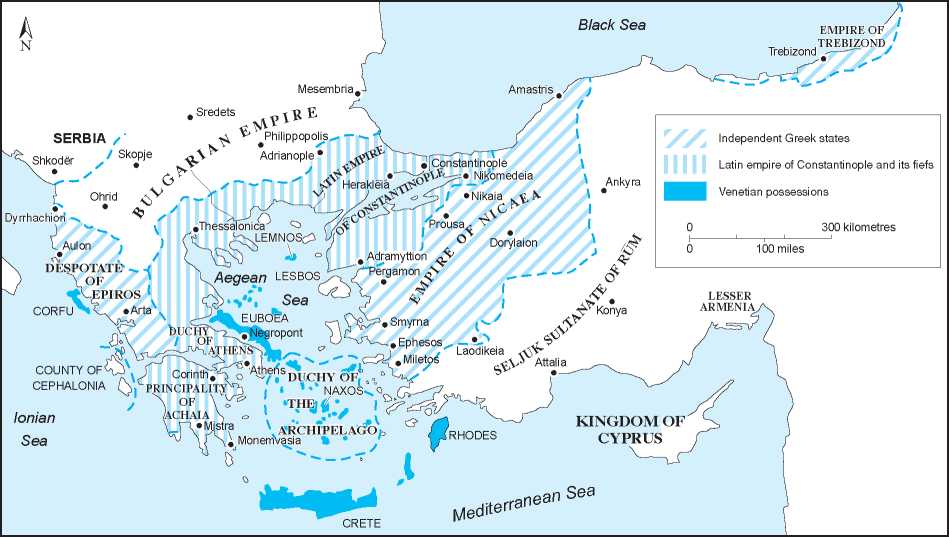The small state based in the region of Epiros (ruled by a despotes, ‘lord’, and hence generally referred to as a ‘despotate’), although it usually included Kephalenia/Cephalonia as well, was established by Michael I Komnenos Doukas, who imposed an effective control after 1204 throughout north-west Greece and a considerable part of Thessaly. His brother and successor Theodore was able to retake Thessalonica in 1224, where he was crowned as emperor, thus challenging the emperors of Nicaea who also claimed legitimacy as true heirs to the imperial throne. But in 1242 John III Vatatzes of Nicaea compelled Theodore’s son and successor John to abandon the title of emperor; and by 1246 Thessalonica was under Nicaean rule. The armies of Nicaea extended their control over much of Epiros after their victory at the battle of Pelagonia in 1259, fought because the alliance between Epiros, the Frankish principality of Achaia under William II Villehardouin, and Manfred of Sicily was intended to thwart the rise of the Nicaean ruler Michael VIII Palaiologos. This control was temporary, however, and after 1264 Epiros was ruled by independent despots (despotai) until 1318. Its geographical situation, cut off between the spine of the Pindos range and the Adriatic, facilitated a degree of political separatism and independence from Constantinople until the Ottoman conquest. Because the emperors at Constantinople always insisted on their rights to confer the title of despotes, the rulers of Epiros were viewed as rebels for much of the fourteenth and fifteenth centuries.
From 1318 until 1337 Epiros was ruled by the Italian Orsini family; and after a short Greek recovery, it was taken by the Serbs in 1348. Ioannina and Arta were the main political centres. From 1366 to 1384 Ioannina was ruled by Thomas Komnenos Palaiologos, also known as Preljubovic, the son of the caesar Gregory Preljub who had been Serbian governor of Thessaly under Stefan Uros IV Dusan. Thomas was able to assert Serbian control over northern Epiros and fought with the Albanian lords of Arta in the south, eventually defeating them with Ottoman help. In 1382 his title of despotes was confirmed by the Byzantine emperor at Constantinople. He was assassinated late in 1384, probably by members of the local nobility who objected to his rule. His wife, the Byzantine Maria Angelina Doukaina Palaiologina, remarried the Italian nobleman Esau Buondelmonti, who ruled as despotes until about 1411. As a result of the connections between Esau and the Florentine Acciajuoli, the despotate came under the house of Tocco thereafter, whose rulers were also able to recover Arta from the Albanians. But in 1430 the Ottomans took Ioannina, and Arta fell in 1449. Henceforth Epiros was to be part of the Ottoman empire. Kephalenia was taken in 1479, but Venice seized it in 1500.
After the partition of the Byzantine empire in 1204, eastern Thessaly was ruled by the Franks, while the western regions were disputed by the rulers of Epiros and Nicaea. In about 1267
John Doukas (known as John the Bastard, an illegitimate son of Michael II of Epiros) established himself at Neopatras as an independent ruler, with the Byzantine title sebastokrator. As he attempted to expand his control eastwards, however, he came into conflict with the Emperor Michael VIII, whose attacks he was only able to repel with difficulty together with the assistance of the dukes of Athens and Charles I of Anjou. Venetian support following the conclusion of a favourable trading relationship (Thessaly exported agricultural produce) helped maintain Thessalian independence until the arrival in 1309 of the Catalan Grand Company, which occupied the southern districts from 1318.
Hired by Andronikos II in 1303 against the Turks, the company turned against the empire when its demands for pay were not met. It established itself initially in the Gallipoli peninsula, then plundered Thrace and Macedonia, and seized control of the duchies of Athens and Thebes, expelling their Latin lords. Under Aragonese protection they dominated the region until the Navarrese Company, temporarily in the service of the Hospitallers, took Thebes. This opened the way for the Florentine Acciajuoli, lords of Corinth, to take Athens in 1388. The latter then ruled all three regions until their defeat at the hands of the Ottomans in the 1450s. The northern regions of Thessaly remained independent until 1332 under the ruler Stephen Gabrielopoulos. At this point they were taken by John II Orsini of Epiros. In 1335 Thessaly was retaken by the Constantinopolitan ruler, and from 1348 acknowledged the overlordship of the Serbian ruler Stefan IV. After his death (1355), the self-styled emperor Symeon Uros, despotes of Epiros and Akarnania, was able to seize control of both Epiros and Thessaly following the death of Nikephoros II of Epiros in 1358/9, and rule independently. He was succeeded by his son John, who adopted the monastic life in 1373, upon which the caesar Alexios Angelos Philanthropenos took control, governing as a vassal of the Byzantine emperor John V. In 1393 the conquest of Thessaly by Ottoman forces put an end to its independence.
In the Peloponnese the main rival to continued Byzantine authority was the continuous struggle with the Latin principality of Achaia. The principality was at its most successful under its prince William II Villehardouin (1246-1278); but after the battle of Pelagonia (see above) in 1259, he had to cede a number of fortresses, including Mistra, Monemvasia and Maina, to the Byzantines. Internecine squabbles weakened resistance to Byzantine pressure, especially from the 1370s, when one claimant to the principality hired the Navarrese Company to fight for him, which from 1381 exercised effective political control over the Frankish territories. In 1401 the last Navarrese Prince joined with the Ottomans against the Byzantines, but by 1430 the remaining lands of the principality had passed to the Byzantine despotes of the Morea through a marriage alliance.
While the Byzantines lost control of the Peloponnese after 1204, after 1259 imperial territory was slowly expanded at the expense of the princes of Achaia, and in 1349 the Emperor John VI Kantakouzenos appointed the first despotes, his son Manuel, whose capital was the hilltop fortress of Mistra near

Map 9.6 Competing states: Epiros, Thessaly and the Latin territories.
Sparta. Manuel ruled effectively until 1380, restoring order and encouraging a degree of prosperity to the region. By 1430, as a result of intelligent diplomacy, marriage alliances and effective warfare, the Byzantine despot of the Morea controlled virtually the whole peninsula. The Ottoman presence and the fall of Constantinople to the Sultan Mehmet II in 1453 effectively ended this final period of Byzantine rule. The Morea resisted until 1460.




 World History
World History









